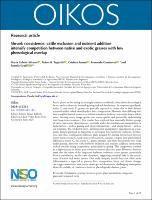Shrunk coexistence: cattle exclusion and nutrient addition intensify competition between native and exotic grasses with low phenological overlap

Voir/
Date
08-06-2025Sustainable development goals
ODS 15 - Vida de ecosistemas terrestres
Type
Artículo
Metadata
Afficher la notice complèteRésumé
Exotic plants are becoming increasingly common worldwide, often driven by ecological factors such as domestic livestock grazing and soil fertilization. In temperate grasslands, native C4 and exotic C3 grasses are generally expected to coexist due to their distinct temporal niches, which should reduce direct competition. However, their differing abilities to exploit limited resources or tolerate vertebrate herbivory can create fitness imbalances, favoring exotic forage species over native species and potentially undermining their long-term coexistence. Few studies have explored how seasonally distinct groups of native and exotic plants interact, especially under the simultaneous manipulation of biotic factors – such as grazing and species interactions – and abiotic factors – such as soil nutrients. We conducted short- and long-term manipulative experiments in a temperate Pampa grassland in Argentina to investigate how herbivore exclusion, fertilization, and their combination influence plant invasion by altering interactions between native warm-season (C4) and exotic cool-season (C3) grasses. Despite their phenological differences, native C4 and exotic C3 grasses interact, and their interactions were weak under grazing. However, with herbivore exclusion and nutrient addition, interactions shifted towards strong competition, particularly in spring. This competition resulted in a slight increase in exotic grass cover over natives after two years. However, fourteen years after the onset of the long-term herbivore exclusion, exotic grasses, particularly Festuca arundinacea, had become dominant, suggesting potential risks to the coexistence of native and exotic species. Our study uniquely reveals that even when niche differentiation is expected to prevent direct competition, biotic and abiotic changes can trigger interactions that favour exotic species' dominance, challenging assumptions about the stability of coexistence between phenologically distinct grasses.
Keywords
Mejoramiento nutricional||nutrient improvement||melhoramento do valor nutritivo||amélioration des qualités nutritives, Especie introducida||introduced species||espécies introduzidas||espèce introduite, Planta endémica||endemic plants||planta endémica||plante endémique, Argentina||Argentina||Argentina||Argentine, Herbívoro||herbivores||herbívoro||herbivore, Festuca arundinacea||Festuca arundinacea||Festuca arundinacea||Festuca arundinacea, Pastoreo||grazing||pastoreio||pâturage, Invasión biológica||biological invasions||invasão biológica||invasion biologique, Interacción biológica||biological interaction||undefined||interaction biologique, Monitoreo de pastizales||rangelands monitoring||undefined||suivi des terres de parcours, Ganado bovino||cattle||gado vacum||bovin, Alimentación de ganado vacuno||cattle feeding||alimentação de bovinos||alimentation des bovins, Adaptación||adaptation||adaptação||adaptation, Pradera natural||natural grasslands||gramado natural||herbage naturel, Manejo de praderas||grassland management||gestão de pastagens||conduite des herbages,
Delegation
Sede Central
Éditeur
Pedro Peres-Neto
Is part of
Oikos
Status
restrictedAccess
xmlui.dri2xhtml.METS-1.0.item-uri-link
https://doi.org/10.1002/oik.11211

